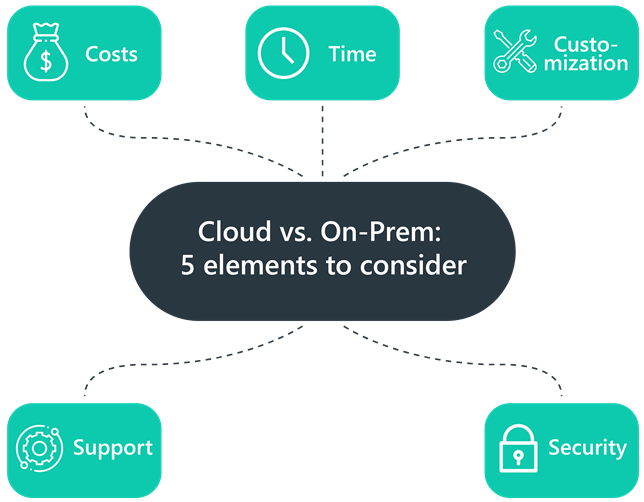Five Elements to Consider Between Cloud Vs. On-Premise
You made it! Management, IT, and Finance teams all agree. It is time to look for a different system that integrates within the different departments of your company. No more Hub and spoke, but instead, an integrated solution that serves all the areas of the business. After careful consideration of different solutions, you found the right partner, but now you’re faced with the question of how you want to deploy the solution for your company. While there may not necessarily be a true right or wrong answer, it’s important to consider the relevant factors to make a well-informed decision to either host your solution On-Premise or in the Cloud.

So, what’s the main difference between a cloud and an on-premise solution?
As the name already indicates, on-premise solutions are installed at the company’s site and hosted on the local server and hardware. While a Cloud solution is based on a centralized, offsite server and managed by a third-party cloud provider. Depending on your company, its IT structure and growth ambitions.
Costs
When looking at the costs involved for your solution, it’s important not only to consider the initial costs related to the deployment but also the ongoing costs of ownership.
An on-premise solution needs a more substantial upfront investment to cover the required hardware and software installments. As the solution is hosted on the company’s local server and hardware, adequate IT staff also needs to be in place or hired and trained accordingly. Finally, significant resources need to be allocated to ensure the system works securely and without issues through upgrades and enhancements.
With a Cloud-based solution, there are no required expenses for hardware as the cloud provider owns this. Similarly, service, maintenance, upgrades, and more are dealt with by the provider. Requiring less dedicated IT to be concerned about keeping the solution working properly. Finally, instead of the upfront investment, a cloud solution is generally using subscription-based licenses, spreading the expenses more evenly.
Time
Deploying and implementing a solution can take up a considerable amount of time. With an on-premise based solution, you have to consider the additional time required to get the right infrastructure in place to run your solution. This time is saved with a cloud-based solution and implementation and generally saves time, especially when it needs to be deployed across multiple locations.
Customization
Depending on your business, you might be looking into the possibility to customize your solution. With on-premise solutions, you’re generally able to customize more, although it can require both time and expenses with additional hardware and possible downtime. While cloud-based solutions can be faster and less expensive, you might be limited in the extent to which customizations can be done.
Support
With on-premise systems, support will be the responsibility of the company itself and will likely require some investment and high involvement from the IT department. With a cloud-based system, the cloud provider generally tackles support issues and often solves them remotely.
Security
This is often one of the most important concerns for customers when talking about a new software solution. With an on-premise solution, the internal IT team is responsible for security as the software and data is installed and stored in-house, within the company. This will likely require additional training for the company’s IT staff together with the rest of the departments. Similarly, with regards to disaster preventation and damage control, backups need to be taken physically offsite in case of an emergency. In contrast, with a cloud solution, the provider is responsible for security. Data is stored in a datacenter, where most providers have safeguards like SSL encryption and multiple layers of authentication by default to help protect the system. Backups are made on a continuous base without effort required from the customer.
Final thoughts
While all very important, these are still not all the elements you should consider when deciding for your system deployment. To make the best possible decision for your business, you have to know your needs and ask the right questions. Get in touch with one of our experts to discuss what option is the best fit for you.
 Nederlands
Nederlands English
English



